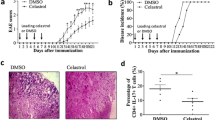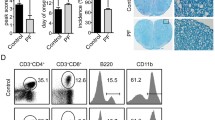Abstract
Experimental autoimmune encephalomyelitis (EAE), an animal mode of multiple sclerosis (MS), was previously considered that is mediated by Th1 cells. However, a number of recent studies provided strong evidence that T helper cells that produce interleukin (IL)-17 (Th17) and anti-inflammatory CD4+ Foxp3+ regulatory T cells (Tregs) play a dominant role in the pathogenesis of EAE. β-elemene is a natural antitumor plant drug with the role of multiple target, and it has been found to pass through the blood–brain barrier easily. It also has been strongly implicated as an immune modulatory agent, but the precise mechanisms of its action are largely unknown. In the present study, we mainly investigated the efficacy and mechanism of β-elemene against EAE in vivo and vitro. The treatment of C57 mice with β-elemene significantly delayed the onset of EAE, markedly suppressed MOG-specific T cell proliferation in a dose-dependent manner, dramatically reduced the IL-17, IL-6, IL-23, and RORγt production and induced the Foxp3 expression in both the periphery and the inflamed spinal cord. These findings indicated that β-elemene amelioration EAE was, to a large extent, due to inhibit differentiation and development of Th17 cells depends on down-regulating expression of IL-6, IL-23, RORγt signaling, and promoting expansion in Treg cells. Suggesting it is useful in the control of MS and other Th17 cell-mediated inflammatory diseases.






Similar content being viewed by others
References
Bettelli E, Carrier Y, W G et al (2006) Reciprocal developmental pathways for the generation of pathogenic effector TH17 and regulatory T cells. Nature 441:235–238
Bettelli E (2007) Building different mouse models for human MS. Ann NY Acad Sci 1103:11–18
Chen W, Jin W, Hardegen N et al (2003) Conversion of peripheral CD4+ CD25− naive T cells to CD4+ CD25+ regulatory T cells by TGF-beta induction of transcription factor Foxp3. J Exp Med 198:1875–1886
Coffman RL (2006) Origins of the T(H)1–T(H)2 model: a personal perspective. Nat Immunol 7:539–541
Fernandez-Martin A, Gonzalez-Rey E, Chorny A et al (2006) Vasoactive intestinal peptide induces regulatory T cells during experimental autoimmune encephalomyelitis. Eur J Immunol 36:318–326
Fontenot JD, Gavin MA, Rudensky AY (2003) Foxp3 programs the development and function of CD4+ CD25+ regulatory T cells. Nat Immunol 4:330–336
Fu N (1984) Antitumor effect and pharmacological actions of β-elemene isolated from the rhizome of Curcuma aromatica. Zhong Yao Tong Bao 9:83–87
Gately MK, Renzetti LM, Magram J et al (1998) The interleukin-12/interleukin-12-receptor system: role in normal and pathologic immune responses. Annu Rev Immunol 16:495–521
Goverman J, Perchellet A, Huseby ES (2005) The role of CD8(+) T cells in multiple sclerosis and its animal models. Curr Drug Targets Inflamm Allergy 4:239–245
Hirota K, Hashimoto M, Yoshitomi H et al (2007) T cell self-reactivity forms a cytokine milieu for spontaneous development ofIL-17+ Th cells that cause autoimmune arthritis. J Exp Med 204:41–47
Huseby ES, Liggitt D, Brabb et al (2001) A pathogenic role for myelin-specific CD8(+) T cells in a model for multiple sclerosis. J Exp Med 194:669–676
Hofstetter HH, Ibrahim SM, Koczan D (2005) Therapeutic efficacy of IL-17 neutralization in murine experimental autoimmune encephalomyelitis. Cell Immunol 237:123–130
Hofstetter HH, Toyka KV, Tary-Lehmann, Paul VL (2007) Kinetics and organ distribution of IL-17-producing CD4 cells in proteolipid protein 139–151 peptide-induced experimental autoimmune encephalomyelitis of SJL mice. J Immunol 178:1372–1378
Ichiyama K, Yoshida H, Wakabayashi Y et al (2008) Foxp3 inhibits RORgammat-mediated IL-17A mRNA transcription through direct interaction with RORgammat. J Biol Chem 283:17003–17008
Ivanov II, McKenzie BS, Zhou L (2006) The orphan nuclear receptor RORgammat directs the differentiation program of proinflammatory IL-17 + T helper cells. Cell 126:1121–1133
Kasper LH, Haque A, Haque S (2007) Regulatory mechanisms of the immune system in multiple sclerosis. T regulatory cells: turned on to turn off. J Neurol 254S:10–14
Kohm AP, Carpentier PA, Anger HA, Miller SD (2002) Cutting edge: CD4+ CD25+ regulatory T cells suppress antigen-specific autoreactive immune responses and central nervous system inflammation during active experimental autoimmune encephalomyelitis. J Immunol 169:4712–4716
Komiyama Y, Nakae S, Matsuki T (2006) IL-17 playsan important role in the development of experimental autoimmune encephalomyelitis. J Immunol 177:566–573
Langrish CL, Chen Y, Blumenschein WM et al (2005) IL-23 drives a pathogenic T cell population that induces autoimmune inflammation. J Exp Med 201:233–240
Liu X, Lee YS, Yu CR, Egwuagu CE (2008) Loss of STAT3 in CD4+ T cells prevents development of experimental autoimmune diseases. J Immunol 180:6070–6076
Manel N, Unutmaz D, Littman DR (2008) The differentiation of human T(H)-17 cellsrequires transforming growth factor-beta and induction of the nuclear receptor RORgammat. Nat Immunol 9:641–649
Mangan PR, Harrington LE, O'Quinn DB et al (2006) Transforming growth factor-beta induces development of the T(H)17 lineage. Nature 441:231–234
McGeachy MJ, Stephens LA, Anderton SM (2005) Natural recovery and protection from autoimmune encephalomyelitis: contribution of CD4+ CD25+ regulatory cells within the central nervous system. J Immunol 175:3025–3032
Mosmann TR, Coffman RL (1989) TH1 and TH2 cells: different patterns of lymphokine secretion lead to different functional properties. Annu Rev Immunol 7:145–173
Nelms K, Keegan AD, Zamorano J, Ryan JJ, Paul WE (1999) The IL-4 receptor: signaling mechanisms and biologic functions. Annu Rev Immunol 17:701–738
Nurieva R, Yang XO, Martinez G et al (2007) Essential autocrine regulation by IL-21 in the generation of inflammatory T cells. Nature 448:480–483
Rachitskaya AV, Hansen AM, Horai R et al (2008) Cutting edge:NKT cells constitutively express IL-23 receptor and RORgammat and rapidly produce IL-17 upon receptor ligation in an IL-6-independent fashion. J Immunol 180:5167–5171
Reddy J, Illes Z, Zhang X (2004) Myelin proteolipid protein-specific CD4+ CD25+ regulatory cells mediate genetic resistance to experimental autoimmune encephalomyelitis. Proc Natl Acad Sci USA 101:15434–15439
Reddy J, Waldner H, Zhang X, Illes Z, Wucherpfennig KW (2005) Cutting edge: CD4+ CD25+ regulatory T cells contribute to gender differences in susceptibility to experimental autoimmune encephalomyelitis. J Immunol 175:5591–5595
Sakaguchi S (2005) Naturally arising Foxp3-expressing CD25+ CD4+ regulatory T cells in immunological tolerance to self and non-self. Nat Immunol 6:345–352
Steinman L (2001) Myelin-specific CD8 T cells in the pathogenesis of experimental allergic encephalitis and multiple sclerosis. J Exp Med 194:F27–F30
Stockinger B, Veldhoen M (2007) Differentiation and function of Th17 T cells. Curr Opin Immunol 19:281–286
Tan P, Zhong W, Cai W (2000) Clinical study on treatment of 40 cases of malignant brain tumor by elemene emulsion injection. Zhongguo Zhong Xi Yi Jie He Za Zhi 20:645–648
Tzartos JS, Friese MA, Craner M et al (2007) Interleukin-17 production in CNS-infiltrating T-cells and glial cells is associated with active disease in multiple sclerosis. Am J Pathol 172:146–155
Viglietta V, Baecher-Allan C, Weiner HL, Hafler DA (2004) Loss of functional suppression by CD4+ CD25+ regulatory T cells in patients with multiple sclerosis. J Exp Med 199:971–979
Wang J, Zhang H, Sun Y (1996) Phase III clinical trial of elemene emulsion in the management of malignant pleural and peritoneal effusions. Zhonghua Zhong Liu Za Zhi 18:464–467
Wei L, Laurence A, Elias KM, O'Shea JJ (2007) IL-21 is produced by Th17 cells and drives IL-17 production in a STAT3-dependent manner. J Biol Chem 282:34605–346010
Wei L, Chuanzhen L (2008) Elemene emulsion attenuate the expression of TNFα, IL-1β, and NO in the striatum of rat focal cerebral ischemia model. Chin J Gerontol 28(7):556–558
Wu W, Liu K, Tang X (1999) Preliminary study on the antitumor immuno-protective mechanism of β-elemene. Zhong-hua Zhong Liu Za Zhi 21:405–408
Yang H, Wang X, Yu L, Zheng S (1999) Study on the anticancer mechanism of elemene (in Chinese). Chin Clin Cancer 26:4–7
Yang L, Anderson DE, Baecher-Allan C et al (2008a) IL-21 and TGF-beta are required for differentiation of human T(H)17 cells. Nature 454:350–352
Yang XO, Nurieva R, Martinez GJ et al (2008b) Molecular antagonism and plasticity of regulatory and inflammatory T cell programs. Immunity 29:44–56
Yang XO, Pappu BP, Nurieva R et al (2008c) T helper 17 lineage differentiation is programmed by orphan nuclear receptors ROR alpha and ROR gamma. Immunity 28:29–39
Zhou L, Liu W, Yu L (2001) Beta-elemene induces apoptosis of K562 leukemia cells (in Chinese). Zhonghua Zhong Liu Za Zhi 23:196–198
Zhou H, Shen J, Hou J et al (2003) Experimental study on apoptosis induced by elemene in glioma cells (in Chinese). Ai Zheng 22:959–963
Zhou L, Ivanov II, Spolski R et al (2007) IL-6 programs T(H)-17 cell differentiation by promoting sequential engagement of the IL-21 and IL-23pathways. Nat Immunol 8:967–974
Zhou L, Lopes JE, Chong MM et al (2008) TGF-beta-induced Foxp3 inhibits T(H)17 cell differentiation by antagonizing RORgammat function. Nature 453:236–240
Acknowledgments
This study was supported by research grants from the China Liaoning Province Education Department (No.2009A733)
Author information
Authors and Affiliations
Corresponding author
Rights and permissions
About this article
Cite this article
Zhang, R., Tian, A., Zhang, H. et al. Amelioration of Experimental Autoimmune Encephalomyelitis by β-elemene Treatment is Associated with Th17 and Treg Cell Balance. J Mol Neurosci 44, 31–40 (2011). https://doi.org/10.1007/s12031-010-9483-1
Received:
Accepted:
Published:
Issue Date:
DOI: https://doi.org/10.1007/s12031-010-9483-1




